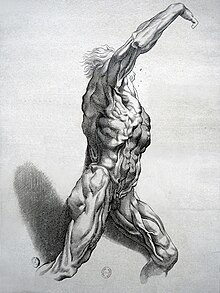Écorché


The écorché (from Latin excortocare , to skin off; Latin stem: ex 'from' and cortex 'bark') describes a style of representation of figures in which people or animals are depicted only with muscles and bones without their skin become. As an anatomical method, it describes preparations in which the internal organs and bones are preserved by removing the skin.
art
There is only evidence that écorché-like methods were used as far back as ancient times . The earliest clear evidence of the artistic écorché can be found in the Renaissance . For nude figures, the architect Leon Battista Alberti recommended that the bones and muscles should be drawn first and then the skin over them. Leonardo da Vinci used this technique in his first studies, depicting animals with broken limbs. In this way he was able to depict the fine structures of the body very precisely. The term écorché itself appears in the French language for the first time in the 18th century in the Dictionnaire de l'Académie françoise of 1787. (In the current French colloquial language, Écorché is used to denote the “muscle man”.) In the USA , the Écorché method is still used in the 21st century at various art schools, such as the New York Academy of Art , the Art Students League of New York and the Academy of Art University of San Francisco .
anatomy
The anatomical preparation technique of the Écorchés can be traced back to the 18th century. It was used in the veterinary school École vétérinaire in Maisons-Alfort , founded in 1765/66, and other French academies. In particular, it was the first director of the veterinary school in Alfort, the anatomist Honoré Fragonard , who made numerous objects using this method. The visitors to his collection, some of which are still in the Musée Fragonard today and about which reports have been received mainly from German naturalists and doctors, were also critical. They saw less valuable objects in the écorchés for teaching the body than representations made of wax ( moulages ).
Web links
- A male figure by Jean-Antoine Houdon from 1767 as l'Écorché
- A male portrayal as Écorché valverde
- A collection of representations in the study of anatomy in 2009
Individual evidence
- ↑ Écorché . In: Dictionnaire de l'Académie françoise , Nimes 1787, Volume 1, p. 409
- ↑ Helmut Mayer: The cabinet of the director Fragonard . In: FAZ , October 17, 2009
